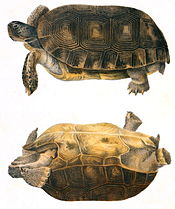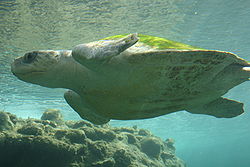- Kemp's ridley sea turtle
-
See also: Olive ridley sea turtle and Ridley sea turtle
Kemp's ridley sea turtle 
Lepidochelys kempii Conservation status Scientific classification Kingdom: Animalia Phylum: Chordata Class: Reptilia Order: Testudines Family: Cheloniidae Genus: Lepidochelys Species: L. kempii Binomial name Lepidochelys kempii
(Garman, 1880)Kemp's ridley sea turtle[1] (Lepidochelys kempii), or Atlantic ridley sea turtle is the rarest sea turtle and is critically endangered. It is one of two living species in the genus Lepidochelys (the other one being L. olivacea the olive ridley sea turtle).
Contents
Anatomy
Kemp's ridley is a small living sea turtle species, reaching maturity at 2–3 feet (61–91 cm) long and averaging only 45 kilograms (99 lb). Typical of sea turtles, it has a dorsoventrally depressed body with specially adapted flipper-like front limbs. Like other sea turtles, it possesses a horny beak.
Distribution
Kemp's ridley sea turtles generally prefer warm waters but inhabit waters as far north as New Jersey, They migrate to the Gulf of Mexico, and Florida where they often inhabit the waters off Louisiana.[citation needed] Their range includes the Atlantic Ocean and the Gulf of Mexico. Almost all females return each year to a single beach—Rancho Nuevo in the Mexican state of Tamaulipas—to lay eggs. Some travel as far away as the coast of Ireland.
Feeding and life history
Feeding
The Kemp's ridley turtle feeds on molluscs, crustaceans, jellyfish, algae or seaweed, and sea urchins.
Life history
Juvenile turtles tend to live in floating sargassum seaweed beds for their first years.[2] Then they range between Northwest Atlantic waters and the Gulf of Mexico while growing into maturity.
These turtles change color as they mature. As hatchlings they are almost entirely a dark gray-black, but mature adults have a yellow-green or white plastron and a grey-green carapace. Some say they reach sexual maturity at the age of 7-15 but others claim that maturity doesn't occur until the age of 35.[citation needed]
The nesting season for these turtles is April to August. They nest mostly in the Mexican state of Tamaulipas, but sometimes on Padre Island in the U.S. state of Texas. They mate offshore. Pregnant females land in groups on beaches in what is commonly called an arribada[2] or mass nesting. They prefer areas with dunes or, secondarily, swamps. The estimated number of nesting females in 1947 was 89,000 but shrank to an estimated 7702 by the 1985.[3]
Females nest three times during a season, keeping 10 to 28 days between nestings. Incubation takes anywhere from 45 to 70 days. There are, on average, around 110 eggs in a clutch. The hatchlings' sex is decided by the temperature in the area during incubation. If the temperature is below 29.5 degrees Celsius the offspring will be mainly male.
Etymology and taxonomic history
These turtles are called Kemp's ridley because Richard Kemp (of Key West) was the first to send a specimen to Samuel Garman at Harvard. However, the etymology of the name "ridley" itself is unknown. Prior to the term being popularly used (for both species in the genus), L. kempii at least was known as the "turtle".[4]
At least one source also refers to the Kemp's ridley as a "heartbreak turtle". In her book "The Great Ridley Rescue", Pamela Philips claimed that the name was coined by fishermen who witnessed the turtles dying after being turned turtle (on their backs). The fishermen said the turtles "died of a broken heart".[5][6]
Conservation
Hunting first depleted their numbers, but today major threats include habitat loss, pollution, and entanglement in shrimping nets.
Mexico first protected Kemp's ridleys in the 1960s. In the United States, the Kemp's ridley turtle was first listed under the Endangered Species Conservation Act of 1970[7] on December 2, 1970, and subsequently under the Endangered Species Act (ESA) of 1973. A binational recovery plan was developed in 1984, and revised in 1992. A draft public review draft of revision number two was published by NOAA Fisheries in March 2010.[8] This revision includes an updated threat assessment.[9]
One mechanism that protects turtles from fishing nets is the Turtle Excluder Device (TED). Due to the fact that the biggest hit to the population of Kemp’s ridley sea turtles is shrimp trawls, the device is attached to the shrimp trawl. It is a grid of bars with an opening at the top or bottom, fitted into the neck of the shrimp trawl. It allows small animals to slip through the bars and be caught while larger animals, such as sea turtles, strike the bars and are ejected, thus avoiding possible drowning.
In September 2007, Corpus Christi, Texas, wildlife officials found a record of 128 Kemp's ridley sea turtle nests on Texan beaches, including 81 on North Padre Island (Padre Island National Seashore) and four on Mustang Island. Wildlife officials released 10,594 Kemp's ridley hatchlings along the Texan coast that year. The turtles are popular in Mexico, as boot material and food.[10]
Oil spills
Some Kemp's ridleys were airlifted from Mexico after the 1979 blowout of the Ixtoc 1 rig, which spilled millions of gallons of oil into the Gulf of Mexico.
The Deepwater Horizon oil spill menaces a wide variety of marine life, from dolphins to blue crabs. Since April 30, 2010, 10 days after the accident on the Deepwater Horizon, they have recorded 156 sea turtle deaths; most of the turtles were Kemp’s ridleys. The National Oceanic and Atmospheric Administration expanded a fishing ban in the Gulf of Mexico because of the spreading oil. Louisiana Department of Wildlife and Fisheries biologists and enforcement agents have rescued Kemp's ridleys in Grand Isle.[11]
Of the endangered marine species that frequent Gulf waters, only the Kemp’s ridley relies on the region as its sole breeding ground.[12]
As part of the effort to save the species from some of the devastating effects of the Deepwater Horizon oil spill, scientists have begun taking eggs from their nests and incubating them elsewhere. Sixty-seven eggs were collected from a nest along the Florida Panhandle on June 26, 2010, and brought to a temperature-controlled warehouse at NASA’s Kennedy Space Center, but only 56 hatched. State and federal officials plan to bring thousands more eggs for incubation in the coming months.
The overall plan is to pluck some 70,000 eggs from sea turtle nests on beaches across Alabama and Florida before they hatch and swim out into the oil from the April 20 Deepwater Horizon rig explosion off Louisiana. NASA currently has about 1,100 eggs at the space center site incubating.[13]
See also
- Chelonioidea. The sea turtle superfamily.
- Caretta caretta. The loggerhead sea turtle.
- Chelonia mydas. The green sea turtle.
- Dermochelys coriacea. The leatherback sea turtle.
- Eretmochelys imbricata. The hawksbill sea turtle.
- Lepidochelys olivacea. The olive ridley sea turtle.
- Natator depressus. The flatback sea turtle.
References
- ^ Turtles of the World: Annotated Checklist of Taxonomy and Synonymy, December 2010, page 000.94
- ^ a b "Kemp's Ridley Turtle (Lepidochelys kempii) - Office of Protected Resources - NOAA Fisheries". NOAA Fisheries. http://www.nmfs.noaa.gov/pr/species/turtles/kempsridley.htm. Retrieved 2009-05-11.
- ^ http://www.nps.gov/pais/naturescience/strp.htm
- ^ Dundee, Harold A. (2001). "The Etymological Riddle of the Ridley Sea Turtle". Marine Turtle Newsletter 58: 10–12. http://www.seaturtle.org/mtn/archives/mtn58/mtn58p10b.shtml. Retrieved 2008-12-30.
- ^ "Frequently Asked Questions". Help Endangered Animals - Ridley Turtles. Gulf Office of the Sea Turtle Restoration Project. http://www.ridleyturtles.org/faq.html. Retrieved 2009-01-05.[dead link]
- ^ Philips, Pamela (September 1988). The Great Ridley Rescue. Mountain Press. pp. 180. ISBN 0878422293.
- ^ http://www.nmfs.noaa.gov/pr/laws/esa/
- ^ Draft Kemp's Ridley Recovery Plan, 2010
- ^ 2010 Threats Assessment, NOAA Fisheries
- ^ Yahoo.com, Endangered turtle nests found in Texas
- ^ photo on Greenpeace USA Flickr via Louisiana Department of Wildlife and Fisheries
- ^ Kaufman, Leslie (May 18, 2010). "Gulf Oil Again Imperils Sea Turtle". The New York Times. http://www.nytimes.com/2010/05/19/science/earth/19turtle.html?hp.
- ^ [1], centurylink.net, July 15, 2010
Bibliography
- Marine Turtle Specialist Group (1996). Lepidochelys kempii. 2006. IUCN Red List of Threatened Species. IUCN 2006. www.iucnredlist.org. Retrieved on 9 May 2006. Database entry includes a brief justification of why this species is critically endangered and the criteria used
- Sizemore, Evelyn (2002). The Turtle Lady: Ila Fox Loetscher of South Padre. Plano, Texas: Republic of Texas Press. p. 220. ISBN 1556228961.
External links
- Profile from the OBIS-SEAMAP project of the Ocean Biogeographic Information System
- Profile from Turtle Trax
- Information from the Coastal Research and Education Society of Long Island wiki
- Profile from the IUCN Red List of Threatened Species
- Information from the Florida Fish and Wildlife Conservation Commission
- http://www.tpwd.state.tx.us/publications/pwdpubs/media/pwd_bk_w7000_0013_kemps_ridley_sea_turtle.pdf
Cheloniidae family of turtles Genus Species of the Cheloniidae familyCaretta Chelonia Eretmochelys Hawksbill sea turtleLepidochelys Kemp's ridley sea turtle · Olive ridley sea turtleNatator Key: Phylogenetic arrangement of turtles based on turtles of the world 2010 update: annotated checklist of taxonomy, synonymy, distribution and conservation status. †=extinct not included.Order Testudines (turtles) Suborder SuperfamilySubfamily
Cryptodira Chelydra · MacrochelysCaretta · Chelonia · Eretmochelys · Lepidochelys · NatatorDermochelysDermatemydidaeDermatemysStaurotypinaeClaudius · StaurotypusBatagur · Cuora · Cyclemys · Geoclemys · Geoemyda · Hardella · Heosemys · Leucocephalon · Malayemys · Mauremys · Melanochelys · Morenia · Notochelys · Orlitia · Pangshura · Rhinoclemmys · Sacalia · Siebenrockiella · VijayachelysAldabrachelys · Astrochelys · Chelonoidis · Chersina · Cylindraspis · Geochelone · Gopherus · Homopus · Indotestudo · Kinixys · Malacochersus · Manouria · Psammobates · Pyxis · Stigmochelys · TestudoTrionychiaCarettochelyidaeCarettochelysTrionychinaePleurodira ChelidinaeChelodininaeHydromedusinaePelomedusa · PelusiosPhylogenetic arrangement based on turtles of the world 2010 update: annotated checklist. Extinct turtles not included.
See also List of Testudines families
 Portal ·
Portal ·  WikiProjectCategories:
WikiProjectCategories:- IUCN Red List critically endangered species
- Lepidochelys
- Reptiles of North America
- Fauna of the Eastern United States
- Fauna of Delaware and Maryland
- Reptiles of Mexico
- Reptiles of Central America
- Reptiles of South America
- Deepwater Horizon oil spill
- Gulf of Mexico
Wikimedia Foundation. 2010.



